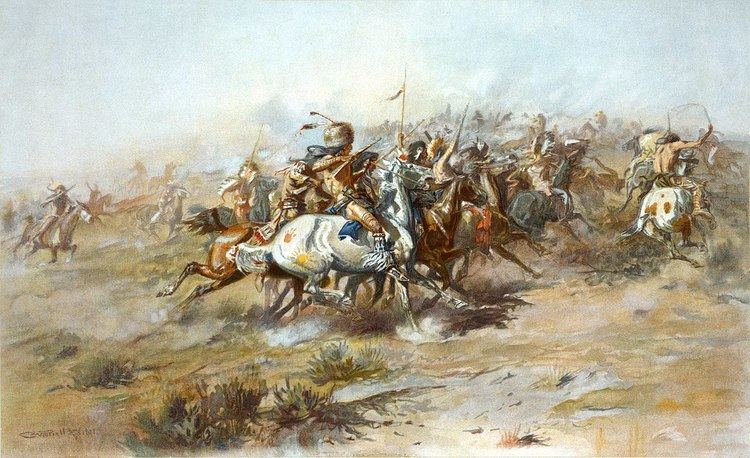~500 soldiers ~400 warriors Date 11 August 1873 | 3 killed, 4 wounded 3 killed, 1 wounded | |
 | ||
Location Treasure County, Montana, United States | ||
The Battle of Pease Bottom, also called the Battle of the Bighorn River was a conflict between the United States Army and the Sioux on August 11, 1873 along the Yellowstone River opposite the mouth of the Bighorn River near present-day Custer, Montana. The main combatants were units of the 7th U.S. Cavalry under Lieutenant Colonel George Armstrong Custer, and Native Americans from the village of the Hunkpapa medicine man, Sitting Bull, many of whom would clash with Custer again approximately three years later at the Battle of the Little Big Horn.
Contents
U.S. Army forces
Custer and ten companies of the 7th Cavalry were part of the Yellowstone Expedition of 1873, a military column commanded by Colonel David S. Stanley accompanying the Northern Pacific Railway survey party surveying the north side of the Yellowstone River west of the Powder River in eastern Montana. Stanley's column consisted of a 1,300 man force of cavalry, infantry, and two artillery pieces (3" ordnance rifles). It traveled with 275 mule-drawn wagons and 353 civilians involved in the survey. Twenty-seven Indian and mixed-blood scouts supported the column.
Native American forces
The Native American forces were from the Sitting Bull's village, estimated at anywhere from 400 to 500 lodges. It included Hunkpapa Sioux under Gall accompanied by the warchief Rain in the Face, Oglala Sioux under Crazy Horse, and Miniconjou and Cheyenne.
Battle
On the morning of August 11, 1873, Custer was encamped with a portion of the 1873 Yellowstone Expedition (Ten companies of the 7th Cavalry and one company of the 22nd Infantry) along the north side of the Yellowstone River at what was later known as Pease Bottom near present-day Custer, Montana. In the early morning hours warriors from the village of Sitting Bull started firing at Custer's camp from across the river, and by dawn skirmishing had broken out in several locations. After Private John Tuttle of Company E, 7th Cavalry was killed in the morning fighting, warriors crossed the Yellowstone River and attacked the rear of Custer's camp. The 7th Cavalry successfully defended their rear from this attack, before the warriors suddenly broke off the fight. The soldiers under Custer soon learned this was because of the approach of Colonel Stanley and the main column. During the battle, Second Lieutenant Charles Braden of the 7th Cavalry was critically wounded, along with two other Private's of the same regiment. Braden's thigh was shattered by an Indian bullet and he remained on permanent sick leave until his retirement from the Army in 1878. He would posthumously be awarded the Distinguished Service Cross in 1925 for his actions during the battle. At least one army horse was wounded during the engagement.
United States Army
United States Army, Lieutenant Colonel George A. Custer, 7th United States Cavalry Regiment, Commanding.
